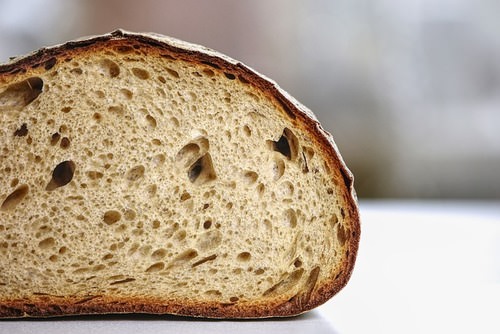厌氧呼吸 - 高级
章节大纲
-
Why does a bakery smell so good?
::为什么面包店闻起来这么香?When bread bakes, yeast releases carbon dioxide gas, forming the small holes in bread. The gas was produced by carried out by yeast.
::当面包烤面包时,酵母释放二氧化碳气体,形成面包中的小洞。气体是由酵母制造的。Anaerobic Respiration
::厌氧呼吸After the photosynthetic “oxygen catastrophe” challenged life between 2.5 and 3 billion years ago, evolution rebounded with biochemical pathways to harness and protect against oxygen's power. Today, most organisms use O 2 in aerobic respiration to produce ATP . Almost all , most , and some are obligate aerobes , which require oxygen. Some plants and fungi and many bacteria retain the ability to make ATP without oxygen. Recall that O 2 is the final electron acceptor at the end of the electron transport chain during aerobic respiration. Oxygen is required for oxidative phosphorylation to produce ATP. But in the absence of O 2 . ATP must still be made.
::在2.5亿到30亿年前的光合“氧气灾难”对生命构成挑战之后,进化过程随着生物化学途径而反弹,以利用和保护氧力。 如今,大多数生物在有氧呼吸中使用氧,以产生ATP。 几乎所有生物,大多数,有些生物和部分生物都具有需要氧气的抗过激素。有些植物和真菌以及许多细菌保留了在没有氧气的情况下制造ATP的能力。回顾O2是氧气呼吸期间电子运输链末端的最后电子接收器。氧化磷是产生ATP所需的氧化磷。但在没有O2的情况下,仍然必须制造ATP。The facultative anaerobes use ancient anaerobic pathways when oxygen is limited. A few bacteria remain as obligate anaerobes , which die in the presence of oxygen and depend on only the first (anaerobic) stage of . Aerobic and anaerobic pathways diverge after splits glucose into two molecules of pyruvate :
::当氧量有限时,畸形厌食动物会使用古老的厌食途径。 少数细菌仍像强制性厌食动物一样存在,它们死在氧气中,仅依赖第一层(厌食)阶段。 溶液分解后,有氧和厌氧路径会分裂成两种蒸发体分子:C 6 H 12 O 6 + 2NAD + + 2P i + 2ADP → 2NADH + 2ATP
::C6H12O6+2NAD+2Pi+2ADP+2ADP+2NADH+2ATPAnaerobic and aerobic respiration share the glycolysis pathway. If oxygen is not present, fermentation may take place, producing lactic acid or ethyl alcohol and carbon dioxide. Products of fermentation still contain chemical energy and are used widely to make foods and fuels. Pyruvate still contains a great deal of chemical energy . In fact, two pyruvate molecules contain most of the chemical energy from the original glucose molecule. If oxygen is present, pyruvate enters the for complete breakdown by the and electron transport chain. If oxygen is not present, must transform pyruvate to regenerate NAD + in order to continue making ATP. Keep in mind that glycolysis produces a net total of 2 ATP.
::蒸发剂仍然含有大量的化学能量。 事实上, 两个蒸发剂分子含有原葡萄糖分子中的大部分化学能量。 如果存在氧气, 蒸发剂进入完全断裂状态, 由电子运输链进入。 如果没有氧气, 就必须将蒸发剂转化成再生NAD+, 以便继续生成ATP 。 记住, 液解作用产生净总量为 2 ATP 。Two different pathways accomplish the regeneration of NAD + with rather famous products: lactic acid (C 3 H 6 O 3 ) and ethyl alcohol (C 2 H 6 O) ( Figure ). Making ATP in the absence of oxygen by glycolysis alone is known as . Therefore, these two pathways are called lactic acid fermentation and alcoholic fermentation . If you lack interest in organisms, such as yeast and bacteria, which have “stuck with” the anaerobic tradition, the products of these chemical reactions may still intrigue you. Fermentation makes bread, yogurt, beer, wine, and some new biofuels. In addition, some of your body's cells are facultative anaerobes, retaining one of these ancient pathways for short-term, emergency use.
::两种不同的途径都用非常著名的产品实现NAD+的再生:杀菌酸(C3H6O3)和乙醇(C2H6O)(图 )。光通过胶解法在缺氧情况下使用氧气进行ATP,这被称为 。 因此,这两条途径被称为乙酸发酵和酒精发酵。如果你对诸如酵母和细菌等具有厌氧传统的有机物缺乏兴趣,那么这些化学反应的产物仍可能令你着迷。 发酵使面包、酸奶、啤酒、葡萄酒和一些新生物燃料成为发酵。 此外,你身体的一些细胞是疏松的异细胞,保留了这些古老的路径中的一条,用于短期紧急使用。Gut Fermentation
::Gut 发酵Behind each release of gas is an army of gut bacteria undergoing some crazy biochemistry . These bacteria break down the remains of digested food through fermentation, creating gas in the process.
::气体释放的背后是一系列直肠细菌,它们正在经历某种疯狂的生物化学。 这些细菌通过发酵分解消化食物的残渣,在过程中产生气体。Summary
::摘要-
In the two to three billion years since photosynthesis added oxygen to Earth's atmosphere, life has become mostly aerobic.
::自光合作用给地球大气添加氧气以来的20亿到30亿年间, 生命已经变得主要是有氧的。 -
Some organisms and types of cells retain the older, anaerobic pathways for making ATP; these pathways comprise anaerobic respiration or fermentation.
::一些生物体和种类的细胞保留了较老的、厌氧的ATP生产途径;这些途径包括厌氧呼吸或发酵。 -
Obligate aerobes require oxygen to make ATP. Facultative anaerobes make ATP with oxygen, but if oxygen levels become low, they can use fermentation.
::强制异体需要氧气才能制造ATP。 修养性异体用氧气制造ATP, 但是如果氧气水平降低, 它们可以使用发酵。
Review
::回顾-
Define fermentation.
::定义发酵。 -
What are the two paths of fermentation and how do they differentiate?
::发酵的两种途径是什么?它们是如何区分的? -
Describe obligate aerobes, obligate anaerobes, or facultative anaerobes, and give examples.
::描述有义务的禁闭、有义务的禁闭、或习惯性的禁闭,并举一些例子。
-
In the two to three billion years since photosynthesis added oxygen to Earth's atmosphere, life has become mostly aerobic.

